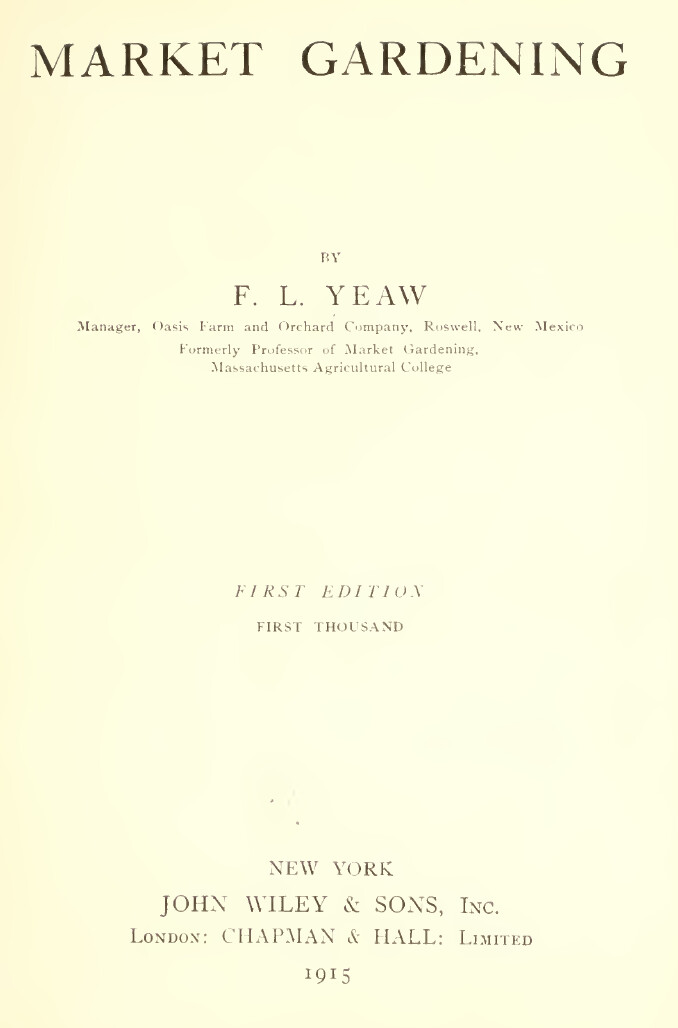$2 Download. Market Gardening. 1915 – 130
PREFACE
The income from the sale of vegetables is practically
twice that produced from the great fruit industries of the
country. Only recently, however, is Market Gardening
receiving the attention that it merits as a subject in which
valuable instruction may be given in our schools.
The purpose of this little manual is to furnish, in a con densed
and usable form, information concerning methods
and best practices for growing and marketing the com moner
vegetables. It is designed primarily for use as
an elementary text on market gardening.
Methods for the propagation, preparation of the soil
for, planting, cultivation, harvesting and marketing of
twenty-tliree of the more connnon and hardy vegetables
are considered in detail. In addition, such information
is given concerning soils, fertilizers, moisture requirements,
seeds, germination, the preparation and care of hot beds
and the storing and packing of vegetables as is necessary
to a reasonably complete understanding of the whole
problem. A special chapter is devoted to the location,
planning and care of home and school gardens.
Growers of vegetables in a small way for the home
table, as well as those engaged in market gardening on
a commercial scale, it is believed, will find this a practical,
reliable and handy guide.
F. L. Yeaw.
CONTENTS
CHAPTER I
Location for the Market Garden. Cultivation
PAGE
Market — Soil — Exposure — Labor — -Water — Tools — Cultivation. . . 1
CHAPTER II
Fertilizers
Stable Manures — Composting — Chemical Fertilizers— Nitrogen
—
Nitrate of Soda — Potash — Phosphoric Acid — Complete Fer tilizers —
Soil Acidity — Lime — Green Manures — Legumes
Ploughing Under — Catch Crops 9
CHAPTER III
Hot Beds
Uses — Location — Means of Heating — Construction — Preparation
of the Manure — Care 19
CHAPTER IV
Seeds and Seed Sowing. Transplanting
Quality of the Seed — Germination — Seed Beds — Planting —
Transplanting 24
CHAPTER V
Irrigation
Moisture Requirements of Plants — Methods of Irrigation 32
V
VI CONTEXTS
CHAPTER VI
Vegetable Gardens
PAGE
The Home Garden — School Gardens 36
CHAPTER VII
Storing and Packing
Storage Cellars and Pits — Storing Root Crops — Celery — Onions
and Cabbage — Packing 43
CHAPTER VIII
Crops
Propagation, preparation of soil for, planting, cultivation, harvesting
and marketing of the following: 1. Asparagus. 2. Beans.
—
3. Beets. — 4. Cabbage. — 5. Bru.ssels sprouts. — 6. Cauliflower.
7. Celery. — S. Cucumbers. — 9. Dandelion. — 10. Egg Plant.—
11. Hor.>e-radish.— 12. Lettuce.— 13. Muskmelon.— 14. On ions. —
15. Parsnips. — 16. Salsify. — 17. Pea. — 18. Radi.sh.—
19. Rhubarb. — 20. Spinach.— -21. Scjuash. — 22. Sweet corn.
23. Tomatoes 53
xMAKKET GAKDEXIXG
CHAPTER I
LOCATION FOR THE MARKET GARDEX. CULTR'ATIOX
The location of tlie market garden is determined by a
number of factors, the most important of which are market,
soil, transportation facilities, labor supply, manure supply
and water.
1. Market. The market, and nearness to market, are
of first importance in choosing the location for the market
garden. The grower must have a sure and dependal^le
market for iiis products; the larger cities generally' afford
the steadiest and most dependable markets. j\Iost of the
products of the market garden are of a perishable nature;
if the garden is not located close to a market, within
hauling distance, the express or fast freight service must
be efficient and dependable. The condition of the roads
is of vital importance to the grower who intends to haul
his produce to market with a team or auto truck.
2. Soil. The soil is of secondary importance to the
market. A market must be had in which to dispose of
the produce; but a good gardener can build up and improve
the average soil so that it will protluce good crops of most
vegetables, while it might be impossible to create or build
up a market.
ROSWELL, N. M.
April, 1915.
iii





